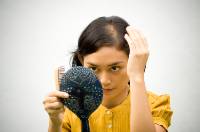There are many factors related to the cause of hair loss in woman. Over 30 million women in the US suffer from hair loss in one form or another. The main cause of hair loss in woman can be attributed to hormonal changes caused by pregnancy or menopause, or to genetics. In the case of pregnancy, the hair loss is almost always temporary and reverses on its own. On the other hand, hair loss during and after menopause has a complex set of genetic and hormonal interactions that make women as susceptible to hair loss as men.
When a woman begins to lose her hair, it’s often less noticeable than in a man. Men develop true bald spots at the temples, frontal hairline and crown. With the hormonal cause of hair loss in woman, the woman’s hair thins all over her head, but is especially noticeable just behind the frontal hairline in an oval pattern. Rarely are there actual bald spots. When an area on the scalp has lost about half of its hair, balding is more easily seen.
Click Here And Learn The Best Treatment For The Leading Cause Of Hair Loss In Woman!
Genetics also plays a major part in the cause of hair loss in woman. In fact, a combination of genetic and hormonal factors conspires to cause the most common type of hair loss in both men and women, androgenic alopecia. The genetic component involves an inherited sensitivity to the action of a specific hormone, dihydrotestosterone (DHT). This sensitivity extends to the hair follicles on the scalp. Even women have testosterone in their bodies, produced by the ovaries and adrenal glands. Testosterone in women is held in check by the balancing presence of estrogen. If anything that disrupts the estrogen level downward, like menopause, testosterone gets the upper hand. When an enzyme converts testosterone DHT, the cycle of hair loss begins in both women and men.
Remember those genetically sensitive hair follicles? DHT attacks them, causing the hair they produce to be thinner and thinner until eventually the follicles become inactive and stop growing hair. Hair begins to thin in classic male- or female-pattern-baldness. This cause of hair loss in woman (and man) is treatable. To counter the increased testosterone, a doctor may proscribe estrogen for a woman. This will restore the hormonal balance in the body so hair loss will slow or stop. Along with estrogen, a growth stimulator like minoxidil could be helpful. Minoxidil encourages the attacked follicles to begin producing hair again, even in the presence of DHT.
Two other prescription drugs may help with androgenic alopecia caused by estrogen deficiency and excessive testosterone production. Although they have FDA approval for uses other than hair loss, there is evidence they can be effective as testosterone blockers to eliminate the cause of hair loss in woman. The first drug is spironolactone, sold under the name AldactoneÒ. The second is finasteride, sold under the names PropeciaÒ and ProscarÒ. Although effective, these drugs can have a disastrous effect on a developing fetus, so they should not be taken by women who are pregnant or may become pregnant.
Androgenic alopecia, a major cause of hair loss in woman, is both a genetic and a hormonal disorder. Effective medical treatments exist. Investigate your options, then see your doctor. Together you can map out a strategy to combat (or even reverse) your hair loss.
Click Here And Learn The Best Treatment For The Leading Cause Of Hair Loss In Woman!

